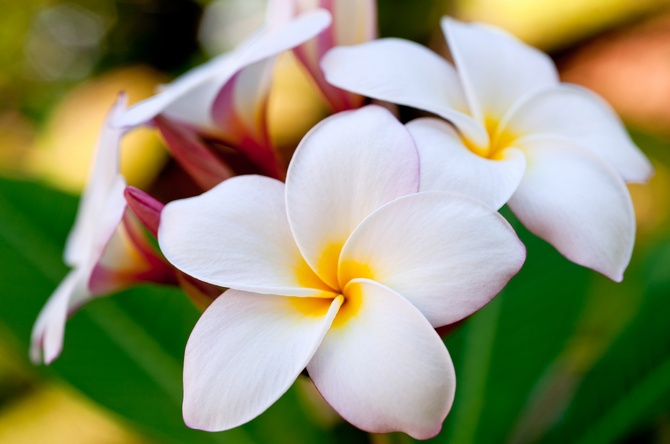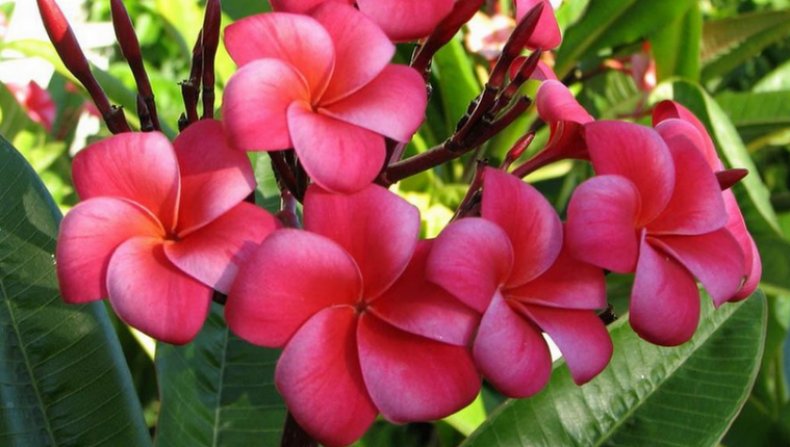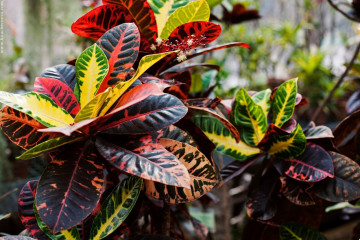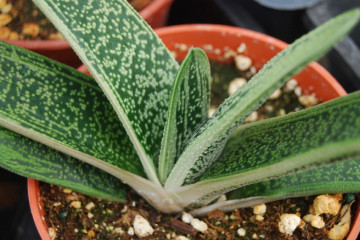Plumeria: home care and breeding methods
Content:
Plumeria is a deciduous crop that belongs to the Kutrov family. The plant was named after the French botanist Plumer. It is also called frangipani. The culture has a beautiful bloom and has a sweet aroma. It is characterized by large inflorescences. In indoor conditions, the bush can reach 2 m.If plumeria is grown, home care should be comprehensive.
What does plumeria look like and what family does it belong to?

Plumeria is characterized by spectacular flowering
According to the description, plumeria is a flower from the Kutrov family. It grows naturally in tropical and subtropical climates. The flower can be in the form of a tree or shrub. The culture is characterized by thick, succulent stems. They are decorated with ovoid, leathery leaves, which are covered with a protruding pattern.
The bush is decorated with large and fragrant flowers that form large inflorescences at the top of the shoots. They differ in size, shape, color. Depending on the species, even the degree of flower opening changes.
Plumeria can bloom white, red, pink, yellow. Multi-colored buds look very impressive. With proper home care for plumeria, you can achieve lush and long-lasting flowering.
History of appearance
According to myths and legends, the Marquis Frangipani and the court botanist Charles Plumier were involved in the emergence and spread of this extraordinary plant. However, there is no exact information about the origin of the culture. However, these legends explain the meaning of the flower's name.
Frangipani plumeria can be found in tropical climates. This flower grows in South America, the Caribbean, Mexico.
The indigenous people of Thailand consider culture to be their national symbol. It is often called that - Plumeria Pattaya. Resort Pattaya, Plumeria Maldives are named after Plumeria. And also the store in Kstovo, named after the plumeria, which once again confirms its popularity.
Common varieties

Red plumeria is considered a popular variety of culture.
Growing rhododendron plumeria is considered a very laborious task. To achieve success in this matter, you can choose the following varieties.
Blunt Plumeria
Under natural conditions, it is a not too tall evergreen tree, which reaches 3-5 m.There are also semi-dwarf species that grow to a maximum of 1.5 m.
Indoors, you can grow a dwarf variety - Plumeria obtusa. This is a compact crop, the branches of which grow up to a maximum of 30-40 cm. It is decorated with dark green velvet foliage. On the reverse side, the foliage is covered with fine fluff. It has a gray-green color.
- Leaves do not exceed 20 cm.
- The flower includes 5 white petals, which are collected on a long peduncle. The extreme parts are slightly bent.
In this case, half of the petal has a bright yellow tint. The flowers of this plumeria are characterized by a pleasant aroma with notes of jasmine.
Plumeria white
The Caribbean islands are considered the birthplace of this plant. There, the culture belongs to medium-tall plants.
The leaves have a smooth leathery surface and a dark green color. On the back, they are silvery.
The flower petals are slightly curled. They are also characterized by a short pedicel. The petals are characterized by a fairly dense arrangement. In the central part there is a small pale yellow eye.
Red plumeria
Under natural conditions, a plant can have 2 varieties - a shrub or a tree.
The culture is considered semi-deciduous. It is characterized by slightly pointed leaves. The plant is decorated with red flowers. This variety is characterized by a wide variety of varieties.
There are species that have inflorescences with several large flowers. There are also varieties with inflorescences of 30 or more flowers. The multi-colored varieties look very original.
Home care
In order for a plant to grow successfully, it needs to be fully and efficiently looked after.
Watering
When growing plumeria at home in the warm season, water the bush immediately after the top layer of the soil dries. For this, it is recommended to use exclusively soft and settled water.
In winter, you need to water the bush significantly less. In this case, it is important to avoid severe dryness of the soil.
Humidity
During the period of active growth, the bushes must be regularly sprayed. For this, it is recommended to use soft and settled water for a day. To increase the parameters of air humidity, it is recommended to pour a small amount of pebbles or expanded clay into the pallet. Then pour water.
In this case, you need to ensure that the bottom of the pot does not touch the liquid in the pan. During spraying, moisture should be avoided on the flowers.

The culture needs high moisture parameters
Temperature
Since plumeria is a tropical crop, it needs warmth.
- The optimal temperature regime in the summer season is +22 .. + 32 degrees.
- In winter, the culture requires parameters at the level of +15 .. + 18 degrees.
- The plant is able to withstand a short drop in temperature up to +13 degrees. In this case, colder air can cause the death of the flower.
The plant grows well in the fresh air. Therefore, in the summer, it is recommended to move it to the balcony or garden. At the same time, it is important to provide the culture with protection from rain.
Lighting
In order for the plumeria to bloom, it needs to provide an optimal level of illumination. The plant requires direct sunlight, which will be the key to healthy development and abundant flowering. For this, the culture must be under the sun for 6-7 hours. Therefore, the frangipani pot should be placed on the southern windowsill.
The east or west side will work as well, but the flowering will be less abundant. The north window is considered the worst option - the plant will not be able to develop normally under such conditions.
Plant transplant
Young plants need to be replanted every year, since rapid development depletes the soil, and the roots are faced with a lack of space.
Mature bushes over 5 years old should be moved to a new location as needed. This is done at intervals of 3 years.For large trees, it is enough to simply change the topsoil.
It is recommended to transplant the flower in the spring. This is done by transferring it to a wide and deep pot. It should be 4 cm larger than the previous one. To avoid stagnation of moisture, a drainage layer must be poured onto the bottom. It can consist of expanded clay.
When choosing a soil, you can give preference to a universal composition with the addition of vermiculite or coarse sand. To avoid mold and rot, it is worth using some charcoal.

When transplanting a flower, you must follow the recommendations of specialists.
Pruning Plumeria
Shoot pruning is permissible only in an adult and healthy culture 4-5 years old. The procedure is carried out with an interval of 2 years. Thanks to this, it is possible to correct the height of the tree and form a beautiful crown.
It is necessary to prune shoots in early spring or immediately after flowering ends. The branches are sensitive to decay, so the procedure should be performed with a sterile instrument. In this case, the cut must be made at an angle.
Reproduction methods
Culture propagation can be done in different ways. This can be done by seed or vegetative method. In this case, it is important to adhere to the step-by-step process of the procedure.
Seeds
Growing plumeria from seeds at home has a number of features. To do this, planting material must be purchased at the store. When self-collecting seeds from hybrids, they often lose the characteristics of the variety.
Before planting, the seeds need to be soaked for 2-3 hours in a growth stimulator. After that, treat them with fungicidal preparations. Loose soil is suitable for planting - you can use a mixture of sand and peat.
The seeds need to be deepened into the soil with lionfish upward so that they remain above the surface. You need to germinate the culture under glass. In this case, the container should be placed in a sunny place. The greenhouse must be regularly ventilated and humidified.

The culture can be propagated by seeds
Cuttings
When using this method, you need to cut a 30 cm long shoot from the bush and soak it in a growth stimulator. Then dry in a dark and cool place for several hours. Cut off the leaves and plant in loose soil, deepening by 8-10 cm. Provide the plant with moderate watering.
Plumeria is a common crop that is distinguished by its spectacular flowering. In order for the plant to develop normally, it must be properly cared for.















